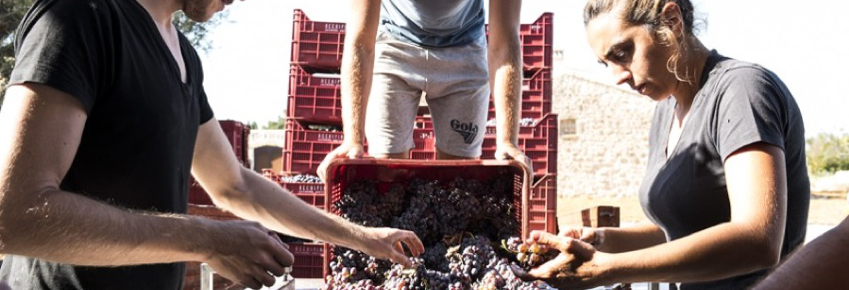We are celebrating the wines of Southern Italy in our store right now. Learn more here:
Calabria
Calabria has ancient ties to viticulture despite its relative lack of wine-fame, both in Italy and internationally. It was this land, the toe tip of the Italian boot, that colonizing Greeks called Oenotria or “the land of staked vine”. The Greek civilization contributed to growth in viticulture and viniculture, but under Roman rule much of Calabria’s vineyards were converted to grain to supply the Roman army. Years of invasions and economic struggles mark the history of Calabria. For a long time it became a supplier of bulk wine (vino da taglio) for Northern Italy and the rest of Europe. The shift towards quality in Calabria is a relatively recent phenomenon and the producer Librandi is widely accredited for this revolution in wine quality, focusing on indigenous grapes: Gaglioppo and Greco Bianco. Bishop’s Cellar is thrilled to bring a little bit of Calabria to Nova Scotia !
Puglia
Puglia, similar to Calabria, was once a bulk wine supplier to the rest of Europe. The 1990s saw a shift towards quality-focused viticulture and winemaking. Puglia is the region that makes up the heel of the Italian boot. It is Italy’s least mountainous region; characterized by plateaus, plains and low hills. This means there is a lot of uniformity and consistency on the wine quality here. It is one of the driest Italian wine regions, where drought is common and irrigation is permitted when needed. It is mainly a red wine region; Primitivo, Negro Amaro and Nero di Troia are flagship indigenous red grapes and, thankfully, can handle the warm, dry weather. For white wines, there are many varieties of Trebbiano, but the noteworthy Puglian whites are Bombino Bianco and Verdeca. Puglia is known for making delicious rosato wines (plural = rosati) and are at their best in the Salento region. Try the wines of Rivera to start your wine journey through Puglia.
 Trullos: traditional Apulian dry stone huts with their famous conical roofs in Puglia.
Trullos: traditional Apulian dry stone huts with their famous conical roofs in Puglia.
Campania
Campania is home to pizza, Mozzarella di Bufala, the Amalfi coast, Naples, and Mount Vesuvius. It is located in Southwest Italy, facing the Tyrhennian sea and bordered by other regions to its North, East and South. It boasts ancient viticultural and winemaking traditions, some dating back 2000 years. Its wines were once praised by Roman Emperors. It has a natural predisposition for viticulture; hilly, ideal soils and climatic conditions as well as many indigenous and unique grapes producing many wine styles. The climate on the coast is Mediterranean, but moving inland towards higher altitudes, the region experiences a cooler continental influence. Red grapes account for 60% of total area under vine, native Aglianico is the star. Plantings of white grapes are on the rise with a focus on indigenous varietals; the main players here are Falanghina, Greco and Fiano.
Classic Mediterranean scenes all over Campania.
Sicily
Sicily’s position in the centre of the Mediterranean Sea has made it a hub of cultural mixing throughout the centuries. It is the largest island in the Mediterrenean and Italy’s largest viticultural region with many terroirs, climatic conditions and native grapes. When Phylloxera ravaged the vineyards in Northern Europe before arriving in Sicily, it became a supplier of bulk wine. This brought economic prosperity to the detriment of wine quality. In the 1980s there was a move towards better grapes and quality wine production; local and foreign interest in the area meant there was a lot of growth. International grapes were planted (Syrah and Chardonnay are the main ones) but thankfully many local growers and producers saw the potential in native grapes and put their efforts there. Catarratto Bianco is still the most planted grape overall in Sicily (it was the workhorse grape for Marsala wine, which at one time was a gem of a fortified wine…not the cheap sweet cooking wine we know today). Other important more interesting whites are Grillo, Ansonica (Inzolia) Grecanico Dorato (same grape as Garganega – Soave) and Zibbibo (Muscat of Alexandria). Around Mount Etna Carricante is the white grape of choice showing lots of potential for high quality. Nero D’Avola is the most planted traditional red (not native to Sicily, but still historically significant). Around Etna, Nerello Mascalese, Nerello Cappuccio make up the reds. Frappato is another traditional red grown in southeast Sicily; Occhipinti crafts great examples of this perfumed, fresh, lively varietal.
Arianna Occhipinti and her team hand sort grapes in Vittoria, Sicily.
Sardegna
Sardegna is a rugged island characterized by rocky hills and mountains, forests and coastal cliffs, long sandy beaches. Located in the western Mediterranean Sea, it is a windy island with diverse soils. Vines are cultivated everywhere. Sardinian wine is marked by Mediterranean scrub (“garrigue” in Frenche) and salty briny notes; the wines have a strong sense of place. Some of the grapes growing today on the island were brought from Spain; Cannonau (aka Garnacha / Alicante), Carignano, Bovale. Another fun fact: Nebbiolo grows here and is considered a traditional grape of Gallura (not native); it was brought to the island during the 18th century during the rule of the House of Savoy (who once ruled Piemonte). The main white grape is Vermentino, the best are from Gallura. Try two beautiful new Dettori wines from this region.
Vermentino in Dettori’s Sardegna region vineyard.


 The vineyards at Librandi
The vineyards at Librandi

